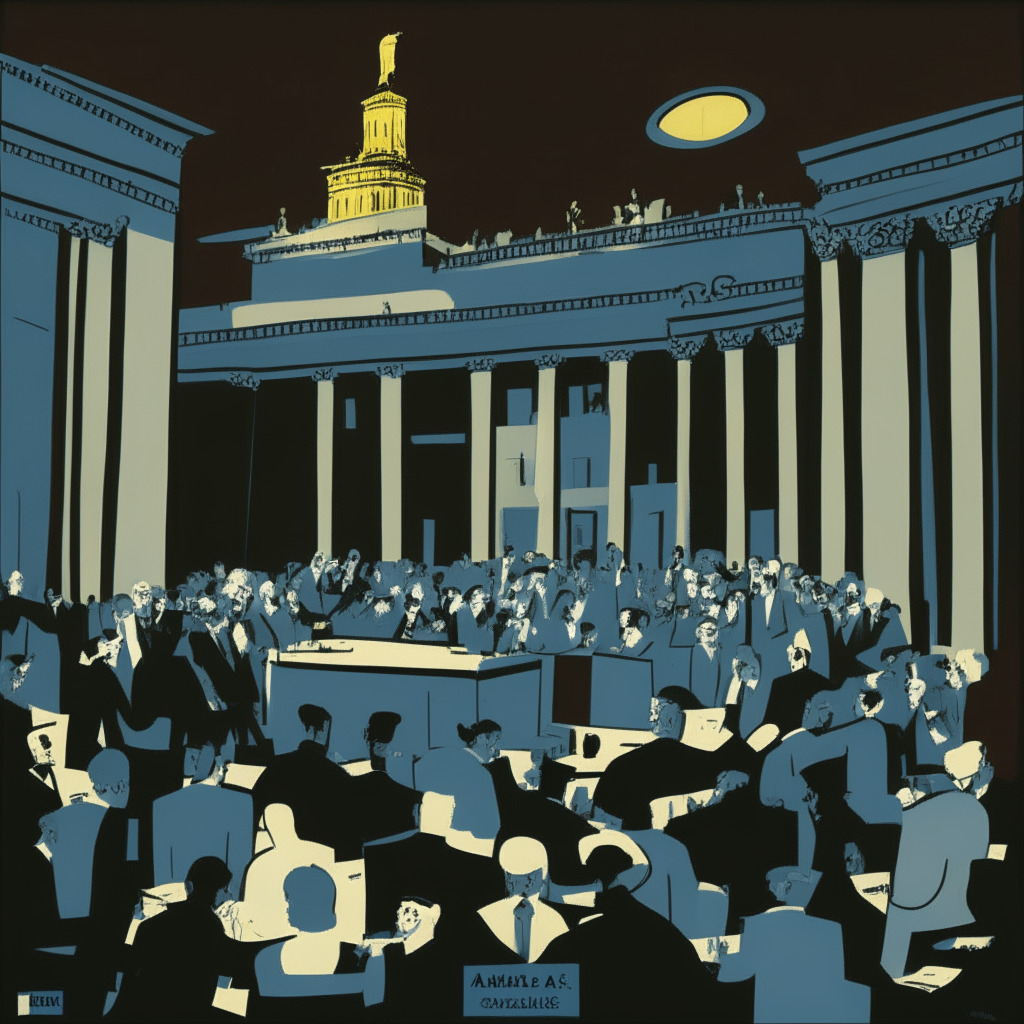“Kenyan parliamentary committee calls for a clampdown on Worldcoin’s operations over data privacy violations. Despite Worldcoin’s skyrocketing popularity, it stirs regulatory turmoil globally. The committee not only demands cessation of Worldcoin but even proposes a new digital asset framework and regulations for cybercrimes and tax reporting.”
Search Results for: Gate
IMF’s Crypto-Risk Assessment Matrix: Unveiling Risks and Recharting Financial Structures
“IMF introduces a crypto-risk assessment matrix (C-RAM), a strategic tool for risk-prone nations addressing cryptocurrency impact on their economy. It considers unique digital assets aspects affecting macro-financial impact. High market volatility and other factors necessitates investors’ protections, with control measures increased by regulators following crashes of Terra Network and FTX.”
Navigating the Dynamic World of Blockchain: Turbulent Tides of Transparency, Legality and Longevity
“UBS Asset Management has initiated a ‘smart contract’ pilot on the Ethereum blockchain, focusing on tokenisation services, including the first live pilot of a tokenized Variable Capital Company fund. Meanwhile, FTX founder’s alleged dismissal of $8 billion in missing funds as a ’rounding error’ sparks concern about fund oversight.”
Navigating the Crypto Maze: IMF’s Risk Matrix vs Globalization Enthusiasts’ Argument
“The International Monetary Fund (IMF) proposes a Crypto-Risk Assessment Matrix (C-RAM) to evaluate risks posed by cryptocurrencies to country’s financial systems. This three-step process includes a macro-criticality assessment, financial indicator analysis, and a systemic-risk evaluation. The tool aims to aid regulators in effectively responding to crypto-related risk triggers.”
FWEN Spectacular On-chain Surge and Rise of Bitcoin Minetrix: A New Era of Accessible Mining
FWEN’s latest on-chain surge surpassed +1,000%, reaching an all-time peak of $0.054300. Meantime, Bitcoin Minetrix (BTCMTX) is challenging the dominance of mega corporations in Bitcoin mining through a novel Stake-to-Mine model, aimed to make mining accessible to everyday investors and democratizing blockchain innovation.
Brazil’s Blockchain Revolution: Tokenizing National Identity with Cause and Concern
Brazil is planning to tokenize the identities of over 214 million citizens through digital documents, using blockchain technology. This initiative, aiming for complete coverage by November 6, promises enhanced security against fraud and improved inter-government collaboration and service accessibility.
Rosbank’s Bold Endeavor: Embracing Digital Ruble Amidst Security Concerns and High Costs
“Rosbank, a trailblazer in the digital currency revolution, invested $1.6 million on integrating its systems with the digital ruble merely two months into the CBDC pilot. Emphasizing on secure transactional gateways, engaging complex cryptography solutions, and investing in specialized expertise, Rosbank stands resolved to overcome challenges of safety concerns, technological hurdles, and costly investments in this digital financial infrastructure.”
Government Shutdown Dodged: Possible Fallout for Cryptocurrency Regulation
“The future of cryptocurrency regulation was at risk with the potential for a government shutdown. This stalemate could have hindered several key crypto-focused bills, including the Financial Innovation and Technology for the 21st Century Act, the Blockchain Regulatory Certainty Act, among others, shaping crypto’s future.”
Ethereum Co-founder’s Warning: DAOs and Vulnerabilities in Staking Pools
In his recent blog post, Ethereum co-founder Vitalik Buterin expressed concerns over Decentralized Autonomous Organizations (DAOs) dominating liquid staking pools, potentially opening doors to network vulnerabilities. He emphasizes the importance of engaging with various liquid staking providers to mitigate systemic risks.
Rollercoaster Ride into Blockchain: Ether Futures ETFs, High-Profile Arrests, and Uncertain Regulations
“Deep shifts in the blockchain realm bring unprecedented changes to its future. Ether futures ETFs are being launched by firms such as Valkyrie and VanEck. However, the looming U.S. government shutdown may disrupt this progress. Meanwhile, the arrest of 3AC’s co-founder Su Zhu, the fraud charges against FTX’s former CEO, and uncertainty among Binance users add to the complex dynamics shaping the blockchain future.”
The Impending Ethereum ETF Rush: Promising Prospects Pitted Against Regulatory Reluctance
“The latest buzz in the crypto world is the potential introduction of a spot Ethereum (ETH) ETF led by Invesco and Galaxy Digital. Conversely, future ETH ETFs seem to be favored by the SEC due to the futures’ presence on the CME and their direct investment in futures contracts, considered as commodities by the regulatory body, protecting against price manipulation.”
Leased Proof-of-Stake: Game-Changer or Just Another Player in Blockchain Technology?
“Blockchain technology introduces Leased Proof-of-Stake (LPoS), an innovative mechanism aimed at overcoming crypto mining complications. LPoS allows tokenholders to lease their tokens to validator nodes, improving their chance at generating new blocks and sharing transaction fees. While offering benefits such as decentralization and fixed tokens, LPoS also maintains control by restricting trade or transfer of leased tokens.”
Legal Uncertainty in Crypto Trials: Balancing Justice with Regulation
“The lawyer for former exchange CEO, Sam Bankman-Fried, contends that the US government’s proposed jury questions could introduce bias. These concerns highlight the need for fair legal frameworks in the blockchain and crypto spaces, amidst skepticism about transparency in crypto regulations and the potential intersection of the crypto market with fraudulent activities.”
Unearthing the JPEX Crypto Scandal: A Cautionary Tale for Investors and Regulators
“In the ongoing JPEX crypto exchange scandal, authorities have apprehended more suspects, taking the total to eighteen. As the investigation unfolds, significant wealth has been seized, and unauthorized Visa cards labeled ‘JPEX’ have been discovered. The scandal underscores the challenges of regulating emerging crypto exchanges and serves as a warning to investors about the need for diligence.”
Navigating Regulatory Waves: How Crypto Exchanges Adapt to Survive
The crypto industry is evolving to navigate tighter global regulations. Exchanges like Kraken and Gemini are developing innovative strategies to thrive. For instance, to overcome regulatory challenges, Kraken is exploring securities trading, and Gemini is expanding in India’s tech-focused market.
Dissecting the Potential $600 Billion Revolution: The Bitcoin ETF Phenomenon
“The possible approval of a Bitcoin ETF could revolutionize crypto trading, mirroring ETFs’ impact on Brazilian markets. Despite challenges and uncertainty with SEC approvals, a potential Bitcoin ETF approval could catalyze a $600 billion demand, surpassing Bitcoin’s current market capacity. This could lead to broader crypto acceptance, making Bitcoin investment highly regulated and accessible.”
Scaling Into the Land of the Rising Sun: Arbitrum Foundation and Fracton Ventures Set to Conquer Japan
“Arbitrum Foundation, a supporter of the Ethereum Layer 2 network, is partnering with Fracton Ventures to tap into the Japanese market. The alliance will focus on ecosystem construction and furnish community education, promoting Arbitrum’s adoption by Japanese developers and investors.”
Zumo’s Compliance with FCA Guidelines: Signifying Innovation and Commitment in Crypto Industry
Zumo, a digital asset-as-a-service platform, became the first cryptocurrency company to incorporate the Financial Conduct Authority’s new financial promotions technical flow guidelines. These rules aim to protect consumers investing in cryptocurrencies. Zumo’s adherence signifies commitment to regulation, user protection, and industry integrity.
Unleashing Blockchain’s Potential: TradeFinex, SBI and the Balance of Transparency vs Regulation
“SBI Holdings is collaborating with United Arab Emirates’ TradeFinex to foster adoption of enterprise blockchain in Japan. This venture offers blockchain-based financial services and provokes a debate over whether such technology enhances financial transparency or circumvents regulatory oversight.”
Bankruptcy Court Approves Liquidation of FTX: A Resilient Crypto Market or a Fall From Grace?
The United States Bankruptcy Court approved the phased liquidation of FTX’s nearly $3.4 billion crypto assets inciting a general sigh of relief among creditors. The carefully planned $7.1 billion liquidation of assets notably Solana and Bitcoin aims to maintain market stability, counter potential market fluctuations, and safeguard the wider crypto market.
Crypto Exodus: Why Gemini and Binance Abandon the Netherlands and What’s Next
“New York-based crypto exchange, Gemini, is ending its operations in the Netherlands due to inability to meet the regulatory requirements. However, it plans to return once it aligns with the new crypto-asset rules under the Markets in Crypto-Assets Regulation (MiCA).”
Nvidia Raided by French Antitrust Agency: Unraveling the Implications for the Digital Industry
French authorities have raided Nvidia offices as part of a larger investigation into the cloud computing sector and potential anticompetitive practices. The implications of this action underscore an ongoing tug-of-war between innovation and market monopolization in the tech industry.
Scaling the Regulatory Walls: Challenges and Solutions for Digital Asset Markets
The World Federation of Exchanges (WFE) proposed six measures to ensure the safety and sustainability of digital asset markets. These include clear segregation of market infrastructure functions and establishing systems to manage user risks. The WFE also emphasized the need for crypto exchanges to demonstrate full backing of user assets and be sufficiently regulated.
Unveiling Off-Chain Transactions: A Step Towards Transparency in Crypto Trades
U.S. Rep. Don Beyer has proposed a bill requiring off-chain digital commodity transactions to be transparently reported. The bill aims to mitigate privacy concerns and risk of fraud by insisting on transparency in crypto trading platforms, requiring them to report all transactions to approved repositories. This move aims to foster confidence within the crypto market and prevent situations similar to the FTX collapse.
Blockchain Alarms: The FTX Founder’s Trial Impact on Future Crypto Regulations
“The trial of FTX founder Sam Bankman-Fried, facing fraud charges, raises important questions within the blockchain community. The high-profile case highlights potential pitfalls of blockchain activities without regulatory oversight, and spurs conversations on clear-cut blockchain regulations, to harness its potential without risking legal repercussions.”
Ripple’s Abrupt Pullout from Fortress Trust Acquisition: Strategic U-Turn or Cautionary Tale?
“Ripple has withdrawn its offer to acquire Fortress Trust, citing a shift in its U.S growth strategy. This follows a substantial monetary loss at Fortress due to a security breach, leading Ripple to reassess and eventually retract its procurement offer, affecting other organizations associated with Fortress Trust.”
Embracing Digital Assets: A Rewarding Yet Daunting Shift for Traditional Financial Institutions
Adding digital assets to traditional portfolios has its unique opportunities and challenges. Navigating the novel landscape of digital assets requires risk management, understanding of blockchain technology, robust cybersecurity protocols, and a focus on legal compliance amidst evolving regulations. Embracing digital assets is a transformative journey redefining conventional financial systems.
Crypto Surge in Brazil: Rising Regulation, Dominance of Stablecoins, and Controversy over CBDC
Brazil, witnessing a 44.2% growth in cryptocurrency adoption between January and August 2023, expresses concerns on potential links to tax evasion. Banco Central do Brasil is intensifying regulation and planning its own central bank digital currency (CBDC), raising discussions on digital financial safety.
Fireblocks and Tezos Integration: A New Era of Security and Scalability in Cryptocurrency
Fireblocks, a provider of cryptographic custody and settlement solutions, has integrated full support for the Tezos network. This partnership enhances security for Tezos-based asset storage and streamlines access to decentralized applications. The collaboration also anticipates a surge in the protocol’s Decentralized Finance activities, contributing to its rising position among all protocols by total value locked.
Navigating Complex Debt: Founder of DeFi Protocol Curve’s Multi-Million Dollar Maneuver
Michael Egorov, founder of DeFi protocol Curve, employed a strategy to settle his extensive obligations on Aave. He deposited millions of CRV as collateral on a lending platform, and borrowed Curve’s crvUSD stablecoin, which he exchanged for USDT to clear his Aave debt. Despite significant outstanding debt across several DeFi platforms, Egorov has been proactive in lessening his debt and usage rate.
Cross-Border CBDCs: A Look at Recent Trials and Cryptocurrency Platform Bankruptcies
“France, Singapore, and Switzerland recently experimented with cross-border Central Bank Digital Currencies (CBDCs) using public blockchain and DeFi technology in a venture named Project Mariana. Despite successful trials, further investigation and iterations are required to fully understand the complexities of implementing such systems.”
Cross-Border Crypto Trading Evolution: Success of Project Mariana and What it Means for wCBDCs
“Project Mariana, a collaboration between the Bank for International Settlements and the central banks of France, Singapore, and Switzerland, has successfully tested a system leveraging cryptocurrency concepts and DeFi technology for seamless cross-border trading in wholesale Central Bank Digital Currencies (wCBDCs).”































